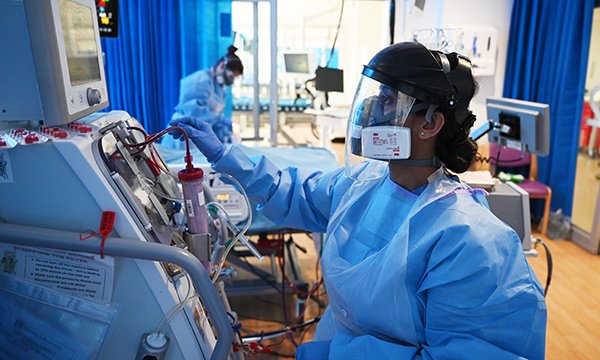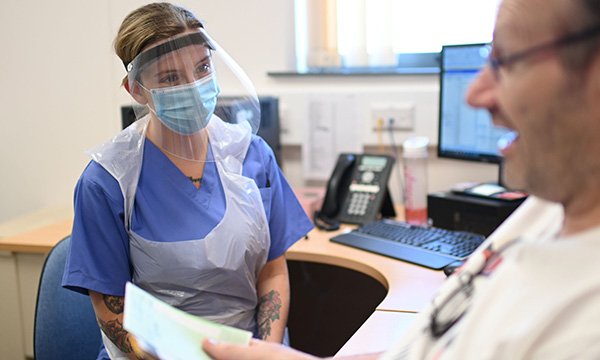2020 – a year like no other for the world in general and nurses in particular

The nursing workforce pulled together to confront the coronavirus pandemic, sometimes at immense personal cost. Six nurses look back on this tumultuous year and how it might have changed nursing for good
- What organisations did well, how teams innovated and the changes that are here to stay
- The lessons that must be learned to keep healthcare staff safe during the second wave
- Nurses consider the toll the pandemic has taken on the workforce, and remember the colleagues who have lost their lives

At the start of 2020 – a year designated International Year of the Nurse and Midwife by the World Health Organization – the global nursing profession was looking forward to its work being celebrated.
Little did anyone know just what this would mean.
Nursing in the spotlight worldwide
One year and a pandemic later, nurses have truly been placed centre stage worldwide.
Here, Nursing Standard invites UK nurses working in different areas of the profession to reflect on a year like no other.
The nurse who crunches the workforce numbers
Alison Leary, professor of healthcare and workforce modelling at London South Bank University @alisonleary1
‘I’m hoping that what we’ve learned during the pandemic shines a light on different kinds of research’

As soon as we saw the coronavirus move into Europe, it became clear it wasn’t going to be easily stopped.
Trying to get ready for the consequences has taken up a lot of our time. With a lot of our research programmes halted, we’ve spent the year doing applied research in the real world, rather than more theoretical work.
A big staffing deficit – even before the pandemic
Even before the COVID-19 pandemic hit, we knew we had a very big deficit of staff and the subsequent surge and demand could only ever create extra stress.
At the outset, we had concerns about mass redeployment as a strategy. To handle an emergency situation, it’s usually fine, but when you have a slow-moving major incident that’s going to last for several months, it’s not sustainable.
‘The lack of emergency workforce planning has been incredibly surprising’
There is bound to be an effect on all the services staff would usually be providing and on that workforce.
For me, the lack of emergency workforce planning has been incredibly surprising. Leveraging extra staff really only extended to students and returners to the register, while other supplementary groups were ignored – those working in industry, in academia and those in the third sector, many of whom were furloughed. I’m not sure anyone explored this avenue.
Contrary to what people may think, we don’t have a shortage of registered nurses; but we do have a shortage willing to work in the NHS.

The energy in the first wave has gone
We’re seeing the results of not having a plan in place right now. We’ve burned through the workforce. In the first wave, staff were enthusiastic and buoyed by public support. We’re not witnessing anything like that in the second surge.
In fact, in our own data we’re now seeing very high ‘intention to leave’ rates. This usually runs at around 15% of the working population, but it’s more like 60% currently.
‘Experience tells us nurses don’t complain, they leave’
It may not always be a reliable measure, as it depends how someone is feeling on the day, but that we’re tracking such consistently high levels is very concerning and shows that many feel neglected.
Experience tells us nurses don’t complain, they leave.
But while there has been a loss of faith in some employers, others have done their very best to ensure the well-being of their workforce, with excellent employment practices.
I’m hoping that what we’ve learned during the pandemic shines a light on different kinds of research, for example, qualitative studies on issues such as long-COVID, where we don’t have the numbers to do quantitative research. That would be among the positives.
Also by Alison Leary
The critical care nurses’ champion
Nicki Credland, chair of the British Association of Critical Care Nurses @credland_nicki
‘Collaborative working is one of the most positive experiences of this pandemic’

This year has been a whirlwind. The arrival of the COVID-19 pandemic meant significant challenges for intensive care nurses.
The pace of change required to ensure policies, training and education were in place for delivery of safe care under extreme circumstances was immense.
This required collaborative working from all the critical care organisations and is one of the most positive experiences of this pandemic.
Working towards a common goal with people who have equal passionate about critical care nursing has been amazing. I include our medical and allied health colleagues in this.
There is a real feeling of being part of a critical care community and looking after each other with mutual respect.
The physical and emotional toll of the pandemic must not be underestimated
Intensive care is a stressful and often emotionally draining environment, even without the added pressure that COVID-19 brought.
Working in personal protective equipment (PPE); caring for a number of extremely complex patients; supporting non-critical care staff redeployed to ICU; and not having contact with our patients’ families – especially at the end of life – has been physically exhausting and psychologically traumatising.
We must never underestimate the toll this experience has had and will continue to have on critical care nursing staff and the wider NHS workforce.
We must protect our staff, because only they can ensure patients receive the gold-standard care we work so hard to deliver.

Mutual supportiveness will help get us through
Moving towards 2021 we continue to face challenges – a second surge and coping with an increase in patients, in addition to the usual added complexity of winter pressures and the flu season.
This will be a difficult time. Only by supporting each other, being kind and accepting help will we get through it.
We must address recruitment and retention of critical care nurses and nurses across the profession.
We must push to ensure critical care nurses are recognised for the specialist role they play in managing the sickest patients in our hospitals. We need to ensure training and education is commensurate with this role and fully supported.
There’s more understanding of what we do – let’s capitalise on that
The year 2021 also brings opportunity. There is an increased understanding of what critical care nursing is; our profile has undoubtably grown over the past year. We need to ensure this continues and use this momentum to push forward our profession and the specialty.
Critical care is an amazing specialty and looking after critically ill patients and their families is a privilege.
Also by Nicki Credland
The advocate for practice nursing
Marie Therese Massey, Queen’s Nurse, independent general practice nurse adviser and former RCN professional lead for general practice nursing @MarieThereseRCN
‘Primary care has to prepare itself for managing the long-term effects of the virus’

The COVID-19 pandemic has brought significant changes to the way primary care services are delivered by general practice nurses (GPNs).
Our GPNs have been swift to embrace new models of delivering care while maintaining essential face-to-face services such as childhood immunisations.
They have demonstrated their flexibility and resilience to meet patients’ needs, particularly the most vulnerable groups, in a variety of settings.
Many GPNs found themselves redeployed into hubs triaging the sickest patients and working in unfamiliar surroundings in full PPE.
Swift transition to virtual services, while maintaining necessary face-to-face contact
There has been a speedy move to virtual services and GPNs have successfully navigated implementation of remote consultations and use of digital technology to continue vital communication with shielding and housebound patients.
Innovative ways have been found to encourage reluctant or fearful patients to attend practices for vital care, including delivering services outside surgery premises in patients’ own cars or other temporary structures.
Collaboration between general practice and social care
We have seen closer collaborative working between community nursing teams and care homes, including training on infection control by GPNs for care home staff.
‘The benefits have been clear: this collaborative approach should, and must, continue’
There has been a rise in home and care home visits by GPNs to provide services normally delivered in-house such as long-term condition checks and wound care.
The benefits have been clear: this collaborative approach should, and must, continue.

Primary care has to prepare itself for managing the long-term effects of the virus, such as those with long-COVID.
Patients may require ongoing nursing care, further increasing demand on a stretched primary care workforce.
In addition to the known effects of long-term ventilation, such as muscle wasting, COVID-19 survivors can experience the consequences of multiple organ failure, including renal and respiratory dysfunction and poor mental health.
We can expect GPNs to play a crucial role in the successful rehabilitation of these patients.
We can look back at 2020 and feel proud of the practice nurse workforce
The past year has had a significant impact on all of us from a personal and professional perspective, causing many of us to reflect on our working relationships, practice and priorities.
We can all be proud of the professionalism and commitment of the GPN workforce to keep patients safe and save lives.
Also by Marie Therese Massey
The voice for Filipino nurses in the UK
Francis Fernando, founding director of the Filipino Nurses Association UK @fernandof1974
‘One positive to emerge has been in bringing together different parts of the UK’s nursing profession and sparking action’

Many nursing staff have sadly lost their lives in the pandemic.
Data shows nurses are at greater risk of dying from COVID-19 than the general population.
But a disproportionately higher number of people from black, Asian and minority ethnic (BAME) backgrounds have died, amplifying historical, structural and systemic racism in our society.
There have been at least 57 deaths of Filipino healthcare workers due to COVID-19 so far in the UK, according to our data.
Similarly, in the US, almost a third (31.5%) of nurses who have died from COVID-19 have been Filipino.
Sorrow was an impetus to take action
One positive to emerge from these sad statistics has been bringing together different parts of the UK’s nursing profession and sparking action for change.
The unanticipated deaths of so many Filipino healthcare workers acted as the impetus for the founding of the Filipino Nurses Association UK (FNAUK) in July.
Our driving values include compassion, learning, opportunity, vision, integrity, empowerment and respect and we’ve worked hard to offer support to our UK Filipino nurse colleagues.

Financial and pastoral support for nurses from the Philippines
Engagement with England’s chief nursing officer Ruth May paved the way for various forms of assistance, including financial grants totalling £20,000 donated by generous private donors to repatriate deceased Filipino nurses.
We provided free workshops on leadership, assertiveness and interview preparation and pastoral assistance for new Filipino nurses arriving in the UK.
In collaboration with the international nurses’ team at NHS England and Improvement, we helped more than 300 nurses stranded in the Philippines during the first wave of the pandemic.
Our association has also supported shielding colleagues with redeployment to non-patient-facing roles. We are working collaboratively with other national and local BAME network associations.
Research into COVID-19 outcomes in BAME populations
FNAUK has been chosen as an official partner of the University of Leicester in ground-breaking research being undertaken on COVID-19 outcomes for the BAME population.
We have more than 3,000 members across the NHS, private care, social care, academia and primary care, but we aim to have 18,000 members within the next two years and be truly representative of Filipino nurses in the UK.
The staff nurse who speaks up against injustice
Nicola Wiafe, staff nurse in a neonatal intensive care unit @nursechat_
‘The topic of racism became a priority discussion and it felt like there were now two pandemics to overcome’

The arrival of the COVID-19 pandemic thrust nurses into the spotlight in the most unimaginable way, and has offered the world a glimpse of what we do.
Natural fears about working in a pandemic were heightened for many by statistics showing that BAME individuals were at greater risk from the virus.
Lack of understanding of why this is, combined with the alarming prospect of minimal PPE and fear of the unknown provided little comfort.
Elevated COVID-19 risk drew attention to race inequalities in society – and healthcare
As people searched for understanding over why BAME individuals were more likely to be affected by COVID-19, attention fell on the stark inequalities that exist in our society and the NHS.
Then the international protests following the untimely death of George Floyd in the US also served as an impetus for change.
The topic of racism became a priority discussion and, for me, it felt like there were now two pandemics to overcome.
I was able to speak up – for the first time – about how racism had affected me
Although disparities in the health service have been documented for years, something felt different this time.
In the past there has been a significant amount of resistance in acknowledging and accepting racism exists.
However, for the first time in my career, it felt like an open and honest discussion about race was being had, and everyone was getting involved.

It was the first time that I too had spoken publicly about racism, inequalities in healthcare and how it had affected me over the years.
People were forced to address and look at their own prejudices: difficult yet necessary conversations, where people were not only speaking out but being listened to.
The healthcare workforce is more self-aware now
Going into 2021, we have been shaped into a more resilient, self-aware workforce with more willingness to change and speak up against prejudice and injustices.
The hard but necessary work now lies in bringing about and implementing long-term change.
Also by Nicola Wiafe
The newly-qualified critical care staff nurse
Madiha Murad, critical care staff nurse at Royal Stoke University Hospital @oh_diya
‘Newly qualified nurses in critical care are now better prepared to deal with future COVID-19 outbreaks’

I took up my first nursing post in October 2019, so I have had to learn to be a registered nurse as well as get to grips with working in intensive care during the COVID-19 pandemic.
Confronted with the same situation, many newly qualified nurses (NQNs) have been forced to step up to meet these unprecedented challenges.
I asked for help from my colleagues and researched COVID-19 to gain competence. This has led me to believe in my ability to help in this pandemic and in becoming more autonomous.
I faced a steep learning curve in bereavement and end of life care
When I started, I lacked skills in communicating effectively in bereavement situations and I knew this skill would be the hardest for me to develop.
Patients at the end of life remain isolated from their families, putting an even heavier burden of loss on their loved ones.
Health professionals have had to find alternative ways to communicate with families, such as video calls, which can mean the last memories of the deceased may be visual rather than physical.
This situation enhanced my sensitivity and empathy as I endeavoured to deliver holistic care.

There has been burnout, but we’re now more adaptable
The high COVID-19 death rate could have led to burnout and distress for many NQNs.
At my own organisation, the critical care management team offered psychological and emotional support.
NQNs working in critical care during the pandemic may have been on an emotional rollercoaster, but they are now better prepared to deal with the current situation, as well as potential future COVID-19 outbreaks.
We have become more resilient and proved we can adapt and respond to the demands of the crisis.

